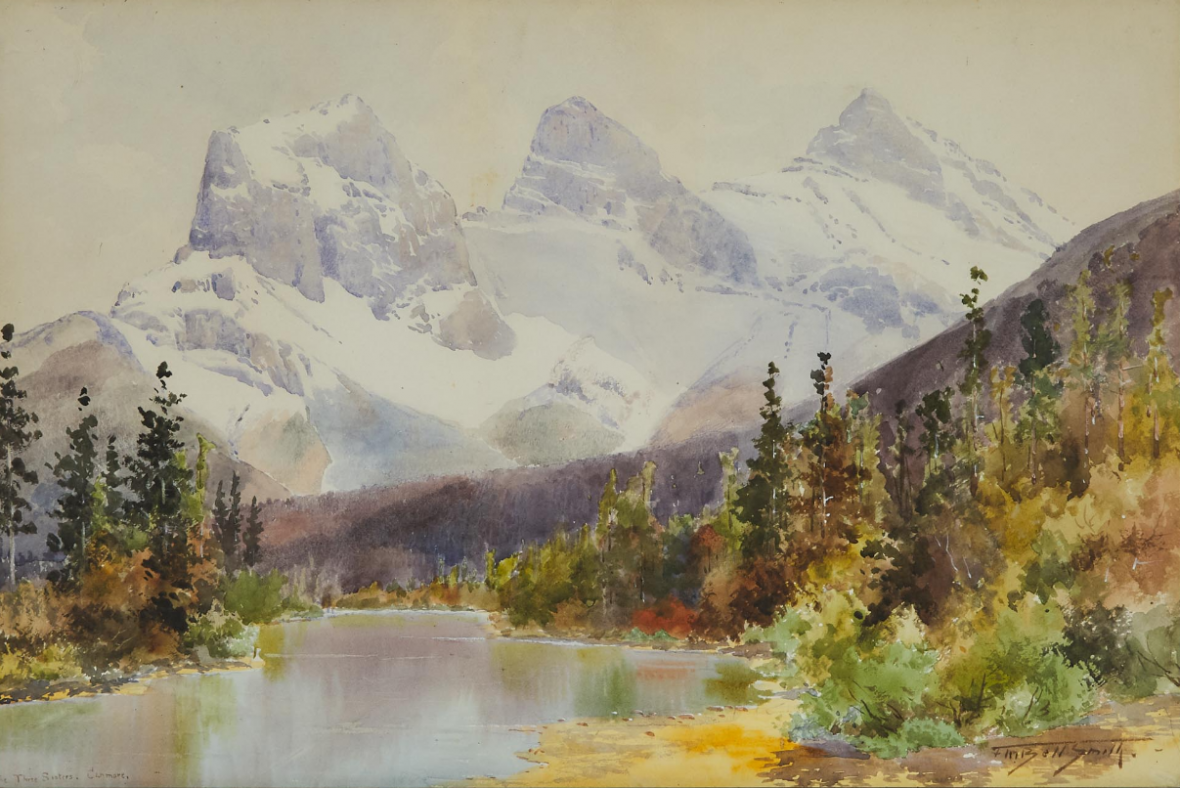Frederic Marlett (F.M.) Bell-Smith - The Three Sisters, Canmore
- The Three Sisters, Canmore
- Watercolour on Paper
- 16 x 24 in
- circa 1915
- Price available on request
- Loch Gallery, Calgary
Signed front lower right titled front lower left
Frederic Marlett Bell-Smith was a major figure in Canadian art history. He was a painter of his age: interested in the great spectacle of nature; striving to capture the beauty and boldness of the rugged Canadian landscape. He was equally fascinated with the cityscapes in which he lived and studied, delivering the feeling of the streets and the bustling boulevards. He desired to paint what he saw with delicacy and accuracy to light and atmosphere, using the watercolour medium with mastery and producing large epic oils which captured the historical happenings of the day. Bell-Smith was classically trained in England and Paris (three visits from the early 1880s to the end of the century) and he was well liked by his "artist brothers". He painted and promoted the Canadian landscape on annual sketching trips across the country from New Brunswick to Victoria for over three decades, and became one of the most popular and prolific painters of the Canadian Rockies of his time.
Born in London, England in 1846, and studying under the tutelage of his father, John Bell-Smith, a respected painter of miniature portraits in London, Frederic began developing his artistic talent. His technical training began at the South Kensington School of Art in England. The development of photography forced portrait artists such as John Bell-Smith to pursue other artistic interests, which is probably the reason for their immigration to Canada in 1867, the year of Confederation. Both father and son missed the prominent artists' organisation's which they had enjoyed in England, and were instrumental in founding the Society of Canadian Artists in Montreal. Frederic was also named a founding member of the Ontario Society of Artists in 1872, and was named an Associate of the Royal Canadian Academy upon its formation in 1880.
His first exhibition of watercolours in 1868 was of sports events at the Art Association of Montreal which included some of his English scenes. A favourite subject throughout his career, scenes of London were recounted with misty atmosphere, dim gaslights and busy figures, bringing the streets and imposing architecture to life. In 1871 he married, then moved to Hamilton, where Inglis had opened another photographic studio.
Bell-Smith first visited the Rocky Mountains in 1887 under a promotional programme designed by the President of the Canadian Pacific Railway, William Van Horne. Along with the photographer William Notman, and the painter Lucius O'Brien, Bell-Smith was among the first to take advantage of the offer, which gave him access to such vistas as Banff, Kicking Horse Pass and Victoria Harbour.
Bell-Smith's sketchbooks contain drawings made in Paris, England and Holland during the early 1890's. It is during these paintings excursions that Bell-Smith became interested in such progressive movements as Impressionism and Tonalism, through such expatriate American Painters as James McNeill Whistler. Bell-Smith had reached a landmark in his artistic career, for at last he was able to make his living from painting alone, without a supplementary salary from teaching.
Bell-Smith's interest in depicting historically important subjects and events of international importance led him to create a series of large oil paintings. In 1894 John Thompson, the prime minister of Canada, died suddenly at Windsor Castle. His body was returned to Canada in one of the finest ships of the day, the Blenheim. This sad event inspired Bell-Smith to paint The Arrival of the Blenheim at Halifax, completed in 1897. Its companion piece, The Queen's Tribute to Canada portrayed Queen Victoria placing a bouquet of flowers on Thompson's coffin within the arched stone walls of Windsor Castle. The last of the series, The State Funeral at Halifax, captures the grandeur of a Canadian state funeral. Bell-Smith sailed to England to paint the Queen's Diamond Jubilee in 1897, from which he produced one large-scale painting and several watercolours.
Over the years, Bell-Smith entered his paintings in as many exhibitions as was possible: shows held by the Art Association of Montreal, the Ontario Society of Artists, The Royal Canadian Academy (at which he was awarded the Governor-General's Gold Medal at its second annual event), the Colonial and Indian Exhibition at South Kensington, the World's Colombian Exhibition in Chicago, the Toronto Industrial Exhibition (in 1893 he exhibited 112 works); and the Pan-American Exhibition in Buffalo, New York (Honourable Mention).
F. M. Bell-Smith approached his art career in his new country with passion and confidence. He applied his rigorous training in traditional artistic techniques to virtually every subject. He excelled in the painting of atmospheric effects such as wet pavement after a shower, the changing London skies, the mist and the fog among the forests of the Rocky Mountains. His popularity was earned with a delicacy of touch, refinement of treatment and poetic charm of composition.
More Artwork from this Artist
The Three Sisters, Canmore
- Watercolour on Paper
- 16 x 24 in
- circa 1915
- Price available on request
London Bridge, River Thames
- Watercolour on Paper
- 18 x 24 in
- CAD $11500.00
The Chancellor, Canadian Rockies
- Watercolour on Paper
- 17.5 x 24.5 in
- circa 1900
- Price available on request
Indigenous Camp, Approach of the Rockies, Alberta, NWT
- Watercolour on Paper
- 10 x 13.5 in
- circa 1905
- Price available on request
Untitled {Crossing the River}
- Watercolour on Paper
- 5 x 6.75 in
- circa 1870
- Price available on request
Barges on the River Seine
- Watercolour on Paper
- 7 x 13.25 in
- Price available on request






